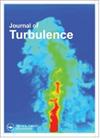蜂窝产生的雷诺数依赖尾流湍流
IF 1.5
4区 工程技术
Q3 MECHANICS
引用次数: 3
摘要
在一定雷诺数范围内,我们对蜂窝流动矫直器的下游流动进行了实验和数值研究,包括蜂窝单元内的层流和湍流流动。利用平面粒子图像测速技术(PIV)在风洞中进行了实验,并进行了数值模拟,对三维流场进行了深入的研究。蜂窝下游的单个通道剖面逐渐发展成一个均匀的速度剖面。这种发展与速度波动的增加相对应,速度波动达到最大值,然后开始衰减。湍流强度峰的位置和大小取决于雷诺数。通过湍流动能(TKE)的计算表明,TKE的产生主要是由蜂窝壁面对应的剪切层主导的。湍流强度的近场和远场衰减可以用幂律来描述,其中我们使用TKE产生项达到最大值的位置作为虚拟原点。本文章由计算机程序翻译,如有差异,请以英文原文为准。
Honeycomb-generated Reynolds-number-dependent wake turbulence
ABSTRACT We present an experimental and numerical study of the flow downstream of honeycomb flow straighteners for a range of Reynolds numbers, covering both laminar and turbulent flow inside the honeycomb cells. We carried out experiments with planar particle image velocimetry (PIV) in a wind tunnel and performed numerical simulations to perform an in-depth investigation of the three-dimensional flow field. The individual channel profiles downstream of the honeycomb gradually develop into one uniform velocity profile. This development corresponds with an increase in the velocity fluctuations which reach a maximum and then start to decay. The position and magnitude of the turbulence intensity peak depend on the Reynolds number. By means of the turbulence kinetic energy (TKE) budget it is shown that the production of TKE is dominated by the shear layers corresponding to the honeycomb walls. The near-field and far-field decay of the turbulence intensity can be described by power laws where we used the position where the production term of the TKE reaches its maximum as the virtual origin.
求助全文
通过发布文献求助,成功后即可免费获取论文全文。
去求助
来源期刊

Journal of Turbulence
物理-力学
CiteScore
3.90
自引率
5.30%
发文量
23
审稿时长
6-12 weeks
期刊介绍:
Turbulence is a physical phenomenon occurring in most fluid flows, and is a major research topic at the cutting edge of science and technology. Journal of Turbulence ( JoT) is a digital forum for disseminating new theoretical, numerical and experimental knowledge aimed at understanding, predicting and controlling fluid turbulence.
JoT provides a common venue for communicating advances of fundamental and applied character across the many disciplines in which turbulence plays a vital role. Examples include turbulence arising in engineering fluid dynamics (aerodynamics and hydrodynamics, particulate and multi-phase flows, acoustics, hydraulics, combustion, aeroelasticity, transitional flows, turbo-machinery, heat transfer), geophysical fluid dynamics (environmental flows, oceanography, meteorology), in physics (magnetohydrodynamics and fusion, astrophysics, cryogenic and quantum fluids), and mathematics (turbulence from PDE’s, model systems). The multimedia capabilities offered by this electronic journal (including free colour images and video movies), provide a unique opportunity for disseminating turbulence research in visually impressive ways.
 求助内容:
求助内容: 应助结果提醒方式:
应助结果提醒方式:


